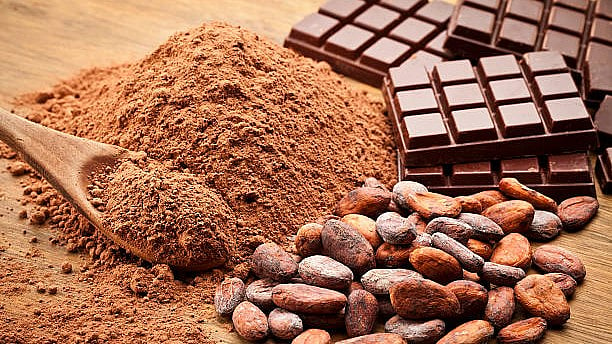
Representative image of chocolate.
Credit: iStock Photo
A birthday celebration? Naturally, a chocolate cake! Valentine’s Day — how could it be complete without a box of chocolates from your beau? A cold day? Perfect for a steaming cup of hot chocolate. And let’s not forget the articles extolling the joys of a “chocolate moment” or the health benefits of dark chocolate when the mood is low.
Like it or not, chocolate has woven itself into the fabric of our lives. Remember the multi-award-winning Chocolat (2000), where a chocolatier (Juliette Binoche) opens a shop in a conservative French village and transforms the entire community?
But now, chocolate lovers are beginning to worry that their indulgent days may soon hit a bitter end. Why? Global warming. Climate change is severely impacting the rainforests where cacao trees — the source of cocoa — grow. Cacao is a delicate fruit. These trees thrive about 20 degrees north and south of the Equator, needing warm weather and heavy rainfall. So, if you’re a fan of Belgian or Swiss chocolates, you might want to reconsider. While these countries are famous for their chocolate, they don’t grow cacao there; they import it from countries in West Africa and South America. In fact, nearly one million farmers in Côte d’Ivoire in West Africa supply cocoa to global giants like Nestlé, Mars, and Hershey. Other major cocoa producers include Mexico, Peru, Ecuador, Brazil, the Dominican Republic, Cameroon, and Indonesia.
Ironically, chocolate — a treat now central to celebrations worldwide, especially in colder climates — actually has its roots in the hot regions of Central and South America. Native to these areas, cacao cultivation dates back at least to 1250 B.C., according to archaeologists.
Chocolate or cocoa ‘drink’ was highly prized by the Aztecs, Mayans, and other Mesoamerican people of Central America. They fermented or used fresh cacao seeds to create various beverages, often flavoured with spices and sweetened with honey. Cacao was traded across Mesoamerica and even made its way into regions where it couldn’t be grown. The beans were so valuable they were used as currency, and chocolate drinks were a status symbol. Returning soldiers were rewarded with chocolate drinks, along with special clothes and flowers. Elites drank it at weddings, betrothals, and to honour foreign diplomats.
Chocolate arrived in Europe via Spain in the mid-16th century. Spanish conquerors, who had developed a taste for it, brought cocoa powder back with them to present to the royal family. The European elite soon built “chocolate rooms” to impress their guests. Hot chocolate became especially popular with French royalty when Marie Therese, a cocoa enthusiast, married Louis XIV in 1660. At the Palace of Versailles, the drink was considered an aphrodisiac.
In 1847, the English company J S Fry & Sons made chocolate more accessible by creating a form that could be eaten rather than drunk. By adding sugar and cocoa butter, they created a malleable paste that could be moulded into solid “eating chocolate.” This method of extracting cocoa butter and making solid chocolate has been followed ever since, dating back to the Industrial Revolution.
Despite rising costs due to supply shortages, chocolate remains a beloved treat. In the US, chocolate sales topped $25 billion in 2023. To keep up with demand, entrepreneurs and scientists have turned to “artificial” production methods, creating cocoa in laboratories. If lab-grown chicken is possible, why not chocolate? California Cultured, a plant cell company, is growing cocoa from cell cultures by soaking it in sugar water to mature in just one week, compared to the usual six to eight months of traditional harvesting. They hope to start selling the product as early as next year.
Another reason for lab-grown cocoa is the growing concern about its environmental impact. Many consumers are questioning how much tropical forest is cleared for cacao cultivation or how much child labour is involved in chocolate production. At the same time, efforts are underway to make cacao plants more resilient in their natural environments. Researchers at major chocolate companies are developing disease-resistant cacao plants. Some are even experimenting with growing cacao indoors, similar to the trend of indoor kitchen gardens. In Israel, a company called Celleste Bio is using cocoa bean cells to produce cocoa powder and cocoa butter in controlled environments. If successful, this approach could make cocoa production less vulnerable to climate change, disease, and pests, which are currently affecting cacao trees in West Africa.
So, chocolate lovers, take heart. Thanks to human ingenuity and biotechnology, you can still indulge in your favourite treat, even if climate change threatens traditional cocoa production.
The Christmas & chocolate connect
In some places, chocolate has become a symbol of Christmas, similar to how turkey symbolises Thanksgiving in the United States. Offering chocolates during the Yuletide season is a gesture of goodwill and affection — another core principle that Christmas stands for. In fact, multiple Christmas traditions involve chocolate.
Chocolate logs: The chocolate log is a tradition that originated in the Middle Ages and is linked to the winter solstice. The chocolate icing is meant to resemble the bark of the wood logs that were once used to heat homes around the fireplace.
Jolabokaflod: An Icelandic tradition where people exchange books on Christmas Eve and read by the fire with hot chocolate.
Chocolate coins: A tradition where chocolate coins are given as gifts, inspired by the deeds of Saint Nicholas in the fourth century with chocolate coins introduced sometime after its introduction into Europe in the sixteenth century.